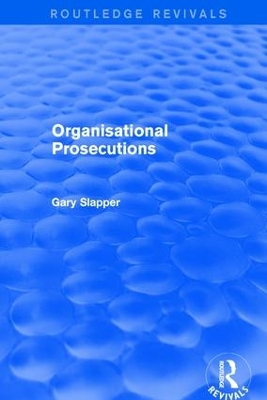Routledge Revivals
3 total works
This title was first published in 2001. The central theme of this book is the activity of the multifarious agencies, local and central government departments, private companies and organizations, which act as prosecutors in the branch of the criminal justice system which deals with 95 per cent of all offences: the magistrates' court. There are over 30 prosecuting organizations (21 are featured in this text) which act regularly in over 400 courthouses in England and Wales. This activity, involving many people and a large amount of resources, accounts for approximately one fifth of all activity in the criminal courts, and yet almost no research has been conducted in this area. Based on a year's extensive study of all of the organization prosecutions brought before three magistrates' courts in different regions, the text analyzes a number of important issues, including the different approaches taken by the different organizations, their conviction rates, and the type of sentencing used for different sorts of cases.
This title was first published in 2001. The central theme of this book is the activity of the multifarious agencies, local and central government departments, private companies and organizations, which act as prosecutors in the branch of the criminal justice system which deals with 95 per cent of all offences: the magistrates' court. There are over 30 prosecuting organizations (21 are featured in this text) which act regularly in over 400 courthouses in England and Wales. This activity, involving many people and a large amount of resources, accounts for approximately one fifth of all activity in the criminal courts, and yet almost no research has been conducted in this area. Based on a year's extensive study of all of the organization prosecutions brought before three magistrates' courts in different regions, the text analyzes a number of important issues, including the different approaches taken by the different organizations, their conviction rates, and the type of sentencing used for different sorts of cases.
First published in 1999, this volume is based upon a detailed empirical study of 40 cases of commercially-related deaths - the first such English study. The cases are taken from 20 towns and cities in England. Slapper critically examines the theory and practice of the legal response to such deaths. The conduct of the Health and Safety Executive, the police, coroner, lawyers and the Crown Prosecution Service are analyzed in detail. He executes his analysis in three stages: events are first scrutinized in the context of the law that governs them; the deaths and official responses are then considered in the context of the psychology of the decision-makers; and finally the dramas are looked at in a wider context of political economy. Slapper draws several disturbing conclusions. His original empirical research, based on attending coroner’s hearings and interviewing those interviewing those involved in enforcing safety laws, shows how and why potentially criminal behaviour at work is constructed as merely regulatory misbehaviour or even as no more than an unavoidable ‘accident’.


